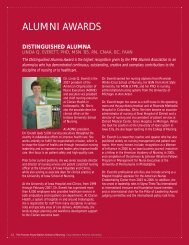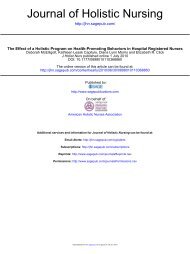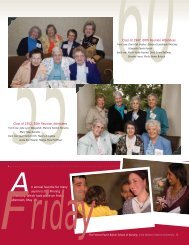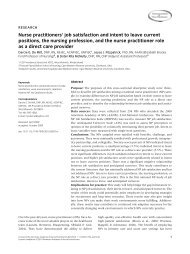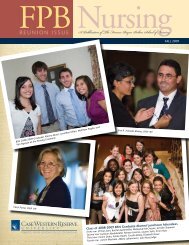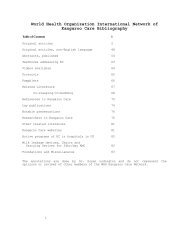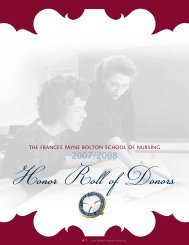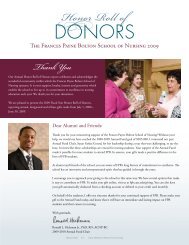Critical Care in the Air - Frances Payne Bolton School of Nursing ...
Critical Care in the Air - Frances Payne Bolton School of Nursing ...
Critical Care in the Air - Frances Payne Bolton School of Nursing ...
Create successful ePaper yourself
Turn your PDF publications into a flip-book with our unique Google optimized e-Paper software.
MSN student Stephanie Ste<strong>in</strong>er and Jonathan Sague, MSN ’06, prepare to pick up a patient.<br />
14 The <strong>Frances</strong> <strong>Payne</strong> <strong>Bolton</strong> <strong>School</strong> <strong>of</strong> Nurs<strong>in</strong>g Case Western Reserve University
<strong>Critical</strong><br />
<strong>Care</strong><br />
Jonathan Sague, MSN ’06, remembers <strong>the</strong> adrenal<strong>in</strong>e rush<br />
he felt <strong>the</strong> first time he shadowed a helicopter transport<br />
team dur<strong>in</strong>g nurs<strong>in</strong>g school. “It was fun. When a call<br />
came <strong>in</strong>, I’d get excited and th<strong>in</strong>k, ‘We’re go<strong>in</strong>g to go<br />
help people,’” he said. These days, Mr. Sague, one <strong>of</strong><br />
<strong>the</strong> first graduates <strong>of</strong> FPB’s Acute <strong>Care</strong> Nurse Practitioner<br />
(ACNP)/ Flight Nurs<strong>in</strong>g Subspecialty, leads critical care<br />
transport teams for <strong>the</strong> Cleveland Cl<strong>in</strong>ic’s Emergency<br />
Services and <strong>Critical</strong> <strong>Care</strong> Department. “It’s not all fun<br />
anymore. It’s an enormous responsibility,” he said. “But I<br />
was well prepared to take care <strong>of</strong> patients <strong>in</strong> all k<strong>in</strong>ds <strong>of</strong><br />
unstructured environments <strong>in</strong> which conditions are not ideal.”<br />
<strong>the</strong><strong>Air</strong> <strong>in</strong><br />
FPB’S UNIQUE SUBSPECIALTY PROGRAM PREPARES<br />
ACNPs TO LEAD ACUTE CARE TRANSPORT TEAMS<br />
by Tim Tibbitts<br />
The <strong>Frances</strong> <strong>Payne</strong> <strong>Bolton</strong> <strong>School</strong> <strong>of</strong> Nurs<strong>in</strong>g Case Western Reserve University 15
W<br />
16 The <strong>Frances</strong> <strong>Payne</strong> <strong>Bolton</strong> <strong>School</strong> <strong>of</strong> Nurs<strong>in</strong>g Case Western Reserve University<br />
When a call comes <strong>in</strong>, Mr. Sague and <strong>the</strong> nurse and paramedic on his team board <strong>the</strong>ir<br />
helicopter and head out. A typical run takes <strong>the</strong> team to a local hospital <strong>in</strong> Nor<strong>the</strong>ast<br />
Ohio to transport a patient to <strong>the</strong> Cleveland Cl<strong>in</strong>ic for care. They also fly to <strong>the</strong> scene<br />
<strong>of</strong> emergencies as needed.<br />
When <strong>the</strong> transport team arrives at <strong>the</strong> referr<strong>in</strong>g hospital, Mr. Sague receives a face-to-face<br />
report from <strong>the</strong> referr<strong>in</strong>g physician and assumes responsibility for <strong>the</strong> care <strong>of</strong> <strong>the</strong> patient.<br />
Throughout <strong>the</strong> flight, Mr. Sague monitors <strong>the</strong> patient, diagnoses changes <strong>in</strong> health status,<br />
and prescribes medications and o<strong>the</strong>r <strong>in</strong>terventions as needed. In <strong>the</strong> traditional flight<br />
transport model, <strong>the</strong> referr<strong>in</strong>g hospital ma<strong>in</strong>ta<strong>in</strong>s responsibility for <strong>the</strong> patient until he or<br />
she reaches <strong>the</strong> next hospital. On <strong>the</strong> o<strong>the</strong>r hand, Mr. Sague’s tra<strong>in</strong><strong>in</strong>g as an ACNP<br />
authorizes him to treat <strong>the</strong> patient from <strong>the</strong> moment <strong>of</strong> pick-up, clos<strong>in</strong>g a critical gap <strong>in</strong><br />
<strong>the</strong> cont<strong>in</strong>uity <strong>of</strong> care dur<strong>in</strong>g <strong>the</strong> “golden hour”—<strong>the</strong> time <strong>in</strong> which an <strong>in</strong>dividual <strong>in</strong> a<br />
serious accident could live or die based on whe<strong>the</strong>r or not he or she receives immediate<br />
critical care. It was <strong>the</strong> desire to close this gap and empower nurses to provide full<br />
diagnostic treatment to patients dur<strong>in</strong>g transport that led to <strong>the</strong> creation at FPB <strong>of</strong><br />
<strong>the</strong> first-ever advanced-practice flight nurs<strong>in</strong>g program <strong>in</strong> <strong>the</strong> country.
“A staff nurse can ma<strong>in</strong>ta<strong>in</strong> a pre-prescribed level <strong>of</strong> care, but with <strong>the</strong> nurse practitioner<br />
model, you have a nurse provid<strong>in</strong>g ongo<strong>in</strong>g diagnostic surveillance and adjust<strong>in</strong>g <strong>the</strong> <strong>the</strong>rapy<br />
accord<strong>in</strong>g to <strong>the</strong> response,” expla<strong>in</strong>ed Chris Manacci, MSN ’03, ACNP, CFRN, director <strong>of</strong> <strong>the</strong><br />
subspecialty program at FPB and an acute care nurse practitioner <strong>in</strong> <strong>the</strong> Emergency Services<br />
and <strong>Critical</strong> <strong>Care</strong> Department at Cleveland Cl<strong>in</strong>ic. “We’re elim<strong>in</strong>at<strong>in</strong>g prescription by proxy,<br />
which is crucial because you can’t delegate judgment.”<br />
The subspecialty program began as a concept analysis paper Mr. Manacci wrote for a class at<br />
FPB, when he was a student <strong>in</strong> <strong>the</strong> MSN program. Mr. Manacci, who worked for seventeen<br />
years as a flight nurse before decid<strong>in</strong>g to pursue his ACNP at FPB, envisioned a program<br />
designed to teach ACNPs to operate where <strong>the</strong>y can’t control <strong>the</strong> variables—such as light,<br />
sound, vibration, wea<strong>the</strong>r, and crowds. “With advice and support from my mentor and advisor<br />
Pr<strong>of</strong>essor John Clochesy, I took my idea to Dean Wykle, and she said, ‘Go for it.’”<br />
In October 2002, FPB and MetroHealth Medical Center <strong>of</strong> Cleveland established <strong>the</strong> National<br />
Flight Nurse Academy and <strong>the</strong> Flight Nurs<strong>in</strong>g Subspecialty with fund<strong>in</strong>g from <strong>the</strong> U.S.<br />
Department <strong>of</strong> Health and Human Services. S<strong>in</strong>ce its <strong>in</strong>ception, <strong>the</strong> program has received<br />
additional fund<strong>in</strong>g from The Elisabeth Severance Prentiss Foundation, Parker-Hannif<strong>in</strong><br />
Foundation, and The <strong>Payne</strong> Fund; however, more fund<strong>in</strong>g is necessary to ensure <strong>the</strong> program’s<br />
cont<strong>in</strong>ued benefits to students and patients.<br />
(Cont<strong>in</strong>ued on page 18)<br />
The <strong>Frances</strong> <strong>Payne</strong> <strong>Bolton</strong> <strong>School</strong> <strong>of</strong> Nurs<strong>in</strong>g Case Western Reserve University 17
Jonathon Sague and <strong>the</strong> critical care transport team assume responsibility for a patient.<br />
18 The <strong>Frances</strong> <strong>Payne</strong> <strong>Bolton</strong> <strong>School</strong> <strong>of</strong> Nurs<strong>in</strong>g Case Western Reserve University<br />
Due to <strong>in</strong>creased need, <strong>the</strong> academy and <strong>the</strong> subspecialty program are expand<strong>in</strong>g. In<br />
2006, Cleveland Cl<strong>in</strong>ic <strong>Critical</strong> <strong>Care</strong> Transport jo<strong>in</strong>ed <strong>the</strong> National Flight Nurse Academy<br />
as a cl<strong>in</strong>ical affiliate. Mr. Manacci is direct<strong>in</strong>g <strong>the</strong> Cleveland Cl<strong>in</strong>ic’s new <strong>Critical</strong> <strong>Care</strong><br />
Transport Program, which will have a world-wide impact, and FPB flight nurs<strong>in</strong>g students<br />
are now able to complete <strong>the</strong>ir <strong>in</strong>ternships at <strong>the</strong> Cleveland Cl<strong>in</strong>ic as well as at<br />
MetroHealth Medical Center.<br />
“The <strong>Critical</strong> <strong>Care</strong> Transport Program at Cleveland Cl<strong>in</strong>ic is essential to our community<br />
and surround<strong>in</strong>g areas. We are able to provide care to patients that may not have gotten<br />
<strong>the</strong> same level <strong>of</strong> care before <strong>the</strong> <strong>in</strong>ception <strong>of</strong> this program. Our relationship with FPB has<br />
enabled us to attract <strong>the</strong> absolute best nurses to provide care for better patient outcomes.<br />
Without that collaboration, we would not have been able to move this program to <strong>the</strong><br />
advanced level so quickly,” said Claire M. Young, MSN, MBA, RN, chief nurs<strong>in</strong>g <strong>of</strong>ficer
at Cleveland Cl<strong>in</strong>ic. “This demonstrates that <strong>the</strong> future <strong>of</strong> excellent patient care is rooted<br />
<strong>in</strong> collaborated efforts between academia and cl<strong>in</strong>ical sites. Dean Wykle was visionary<br />
enough to see that this could work, and <strong>the</strong> results will cont<strong>in</strong>ue to speak for <strong>the</strong>mselves.”<br />
“ We’re elevat<strong>in</strong>g <strong>the</strong> level <strong>of</strong><br />
service by elevat<strong>in</strong>g <strong>the</strong><br />
level <strong>of</strong> <strong>the</strong> provider.<br />
”<br />
The subspecialty is open to anyone pursu<strong>in</strong>g an ACNP at FPB; it requires three additional<br />
courses beyond <strong>the</strong> MSN curriculum, as well as a 600-hour <strong>in</strong>ternship <strong>in</strong> critical care<br />
flight nurs<strong>in</strong>g.<br />
In addition, registered nurses <strong>in</strong>terested <strong>in</strong> pursu<strong>in</strong>g an advanced practice nurs<strong>in</strong>g degree<br />
can sign up for <strong>the</strong> program’s annual summer camp, a week-long, hands-on, <strong>in</strong>terdiscipl<strong>in</strong>ary<br />
tra<strong>in</strong><strong>in</strong>g opportunity. This summer’s camp, featur<strong>in</strong>g topics rang<strong>in</strong>g from helicopter safety<br />
and transport<strong>in</strong>g <strong>in</strong>fectious disease patients to land<strong>in</strong>g zone preparation and work<strong>in</strong>g <strong>in</strong><br />
wilderness and remote areas, will be held <strong>in</strong> August 2008.<br />
FPB’s is <strong>the</strong> only subspecialty program <strong>in</strong> <strong>the</strong> nation to tra<strong>in</strong> ACNPs to lead critical care<br />
transport teams. Soon, however, it will not be <strong>the</strong> only such program <strong>in</strong> <strong>the</strong> world. In<br />
December 2007, Case Western Reserve University and Aichi Medical University College<br />
<strong>of</strong> Nurs<strong>in</strong>g <strong>in</strong> Japan signed a memorandum <strong>of</strong> understand<strong>in</strong>g to beg<strong>in</strong> replicat<strong>in</strong>g FPB’s<br />
cutt<strong>in</strong>g-edge program <strong>in</strong> Japan, <strong>in</strong> a flight nurs<strong>in</strong>g program that will <strong>in</strong>clude Case Western<br />
Reserve University’s name <strong>in</strong> its title.<br />
Chris Manacci believes <strong>the</strong> impact <strong>of</strong> this program goes well beyond <strong>the</strong> goal <strong>of</strong> improved<br />
patient care. “We’re transform<strong>in</strong>g an entire culture by tak<strong>in</strong>g flight nurs<strong>in</strong>g from a staff<br />
nurse level to a nurse practitioner level,” he said. “The purpose <strong>of</strong> this program is to provide<br />
a level <strong>of</strong> service <strong>in</strong> this <strong>in</strong>dustry that hasn’t existed until now. We’re elevat<strong>in</strong>g <strong>the</strong> level <strong>of</strong><br />
service by elevat<strong>in</strong>g <strong>the</strong> level <strong>of</strong> <strong>the</strong> provider.”<br />
The program and <strong>the</strong> work it prepares graduates to do are satisfy<strong>in</strong>g on a personal level as<br />
well. “It’s a real privilege to care for vulnerable people at <strong>the</strong> time <strong>of</strong> <strong>the</strong>ir greatest need,”<br />
Mr. Manacci said. Jonathan Sague agrees. “Be<strong>in</strong>g able to go out and apply <strong>the</strong> th<strong>in</strong>gs I’ve<br />
learned as a nurse practitioner—be<strong>in</strong>g armed with this new knowledge—is very satisfy<strong>in</strong>g,”<br />
he said. “When you’re passionate about someth<strong>in</strong>g, it’s not just a job. I’m very lucky to<br />
wake up for work each day and look forward to <strong>the</strong> day ahead.”<br />
The critical care transport team works <strong>in</strong><br />
tight quarters.<br />
Jonathon Sague confers with Christopher Manacci<br />
after <strong>the</strong> patient has been delivered.<br />
The <strong>Frances</strong> <strong>Payne</strong> <strong>Bolton</strong> <strong>School</strong> <strong>of</strong> Nurs<strong>in</strong>g Case Western Reserve University 19



